Our All About Sensory Bins Guide below is your best resource for getting started with sensory bins. Whether you are making a sensory bin for your home or a classroom, there are a few things to know. Learn about the benefits of sensory bins, what you can use in a sensory bin, and how to make a great sensory bin for toddlers and preschoolers. Sensory bins or sensory boxes for kids are much easier to make than you think!
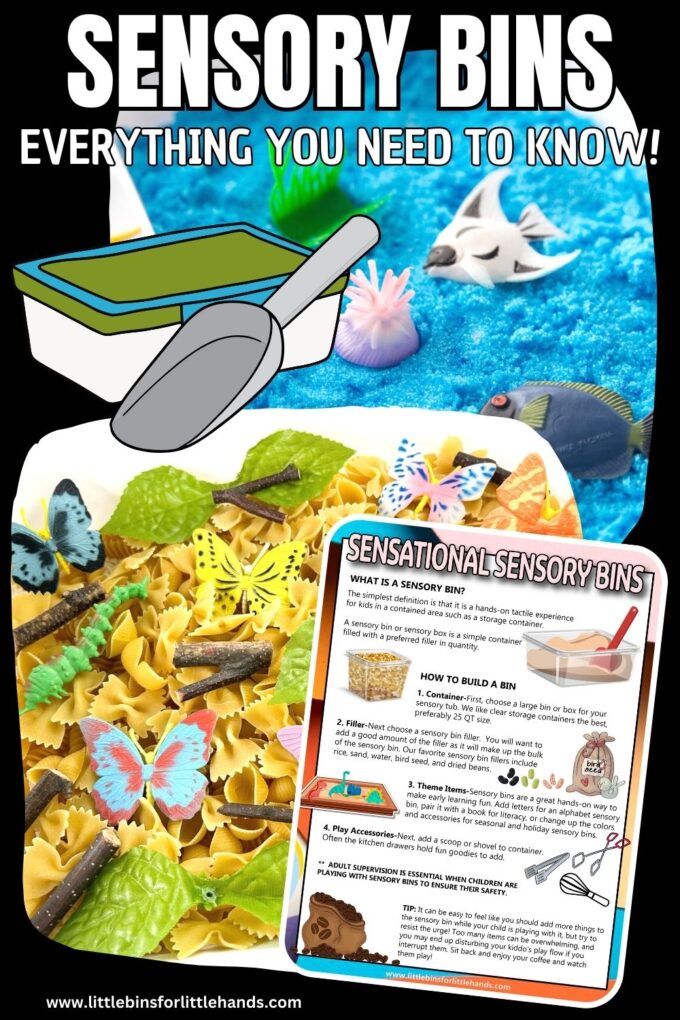
Over the past few years, we have learned a lot about sensory play and, specifically, sensory bins or sensory boxes. I am so excited to share our best sensory bin ideas with you below.
You will also want to check out our Ultimate Sensory Activities Guide, which includes more fun sensory play activities, including sensory bottles, sensory recipes, slime, and more.
These ideas comes from what I have learned from making sensory bins over the last few years. We began using sensory bins long before I understood why my son enjoyed them so much!
Sensory bins can also be part of a discovery table setup. You can see one here with our dinosaur discovery table, farm theme sensory table, and fall leaves discovery table.
I am confident that once you know all about sensory bins, you will create a new sensory bin each week. Learning about sensory bins and making sensory bins will open up a whole new world of sensory play for you and your kids!
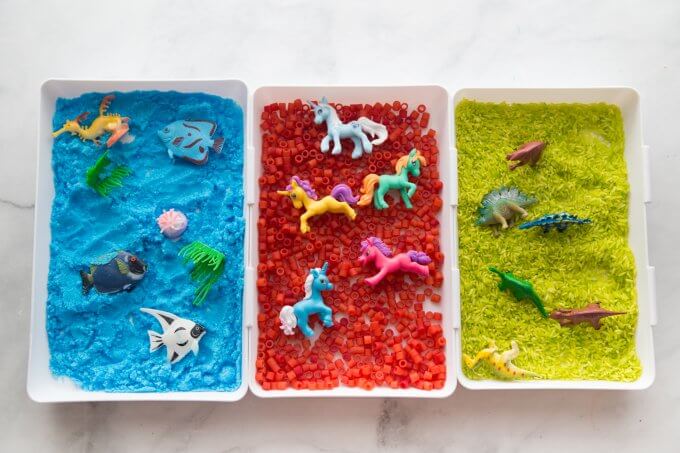
What is a Sensory Bin?
NOTE: We no longer support using Water Beads for sensory bin filler. They are unsafe and should not be used for play with small children.
To make your own sensory bin, you must know what one is! The simplest definition is that it is a hands-on tactile experience for kids in a contained area such as a storage container.
A sensory bin or sensory box is a simple container filled with a preferred filler in quantity. Our favorite fillers include craft sand, birdseed, colored rice, and water!
The container should be large enough to let your child explore without spilling the filler out. A sensory bin can be easily switched for a unique or novel experience whenever you want!
What Age Should You Start Sensory Bins?
The most common ages for sensory bins are older toddlers, preschoolers, and kindergarteners. However, you must be very aware of the filler you choose and the habits of the kiddos you use it with. Heavy supervision is required for kiddos who may want to sample the filler (edible or non-edible).
Adult supervision is very important for safely using sensory bins with young kids!
However, this age group is also perfect for fully enjoying the tactile experience of scooping, pouring, sifting, dumping, and feeling! Note the benefits of using sensory bins below.
As kiddos get older, you can easily add a learning component to the sensory bin, such as our butterfly life cycle sensory bin below. Younger kiddos will enjoy exploring the materials.
What Should Be in a Sensory Bin?
It’s as easy as 1-2-3-4! Start with a container of your choosing, and prepare to fill it! Additional items on hand include themed books, games, and puzzles.
1. Container
First, choose a large bin or box for your sensory tub. I like clear storage containers the best, preferably 25 QT size with measurements of 24″ long, 15″ wide, and 6″ deep. Use what you have if you don’t have these exact measurements! We have used all sorts of sizes, but at least 3″ deep is preferable. See more tips on choosing a sensory bin below.
2. Filler
Then you want to choose a sensory bin filler. You will want to add a good amount of the filler as it will make up the bulk of the sensory bin.
Our favorite sensory bin fillers include:
- rice
- dry pasta
- salt
- dry beans
- birdseed
- water
- aquarium rock
- cloud dough
- homemade kinetic sand
- oobleck
- clean mud
- fake snow
- pom poms and more!
See our list of over 21 favorite sensory bin fillers!
3. Theme Items
Sensory bins are a great hands-on way to make early learning fun. Add letters for an alphabet sensory bin, pair it with a book for literacy, or change up the colors and accessories for seasonal and holiday sensory bins. We have tons of fun theme sensory bin ideas for you below!
4. Play Accessories
Next, add a scoop or shovel and container. I save all sorts of things from the kitchen and collect fun containers from the dollar store! Funnels and kitchen tongs are great fun to add too. Often the kitchen drawers hold fun goodies to add.
Easy To Make Sensory Bin Ideas
Below you’ll find ideas for various sensory bin themes for older toddlers, preschool, and kindergarten. You can easily switch out the filler with one that works better.
Apple Pie Sensory Bin
You will surely want to dig your hands into this fun apple theme sensory bin! Cloud dough is an awesome and simple sensory play recipe that is quick to whip up. Our apple pie scented cloud dough is also taste safe!
Apple Sensory Bin
Here is an easy apple sensory bin idea you will want to set up this fall! Easy to make, and great for fine motor practice, counting, and more.
Dinosaur Volcano Sensory Bin
The dinosaur volcano sensory bin provides an opportunity for kids to learn about dinosaurs, volcanoes, and the natural world in a hands-on way. Not only can kids explore dinosaurs, but they can also dive into facts about volcanoes and observe a simple chemical reaction!
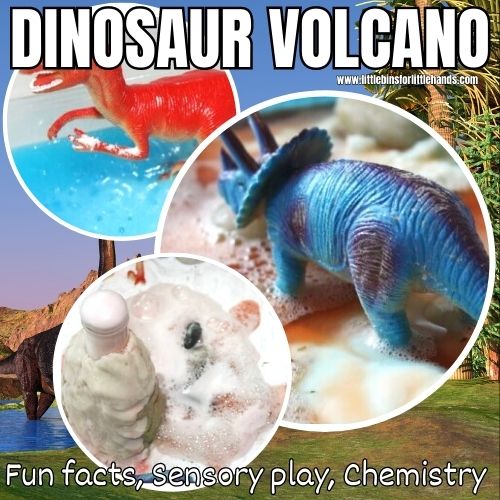
Dinosaur Sensory Bin
Create a dinosaur sensory bin with moldable sand and your favorite dinosaur toys. This sensory bin is a super fun theme for year-round play! Plus, check out the resources to help you assemble an entire dinosaur theme unit.
Ice Cream Sensory Bin
Various size pompoms, silicone baking cups, plastic ice cream scoops, and fun plastic ice cream cone dishes make for a delightful ice cream theme activity. Omit the beads if they are not practical for your age group!
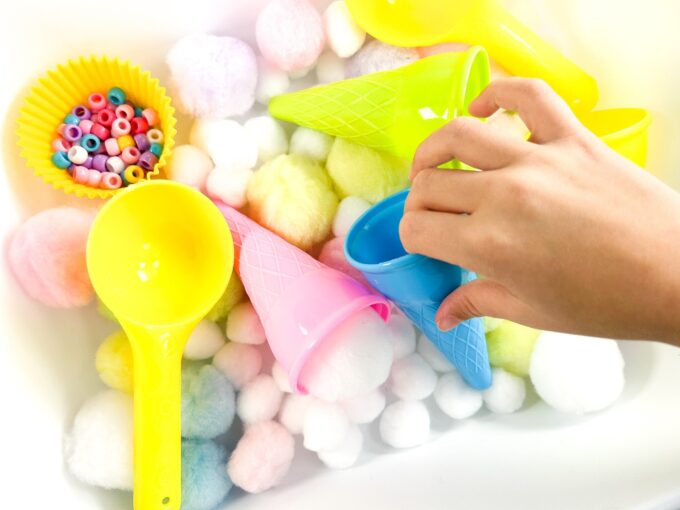
Butterfly Sensory Bin
Set up a butterfly sensory bin to learn about the life cycle of a butterfly for a fantastic way to combine hands-on learning and a tactile experience. Different types of dry pasta mimics some of the life stages of a butterfly!
Chia Seed Sensory Bin
Soak chia seeds in water, to create an unique texture for sensory play. Taste safe, and lots of fun!
Colored Spaghetti Sensory Bin
What’s more fun than colorful rainbow spaghetti for young kids to dig their hands into! Find out how to make rainbow spaghetti for sensory play that’s taste-safe!
Lemon Scented Sensory Bin
Lemon-scented rice is quick and easy to make and is perfect for Olfactory Sensory Processing Input!
Ice Castle Play
Fill the bin with kinetic sand, add in some trees and construction blocks to make your own “ice castles”.
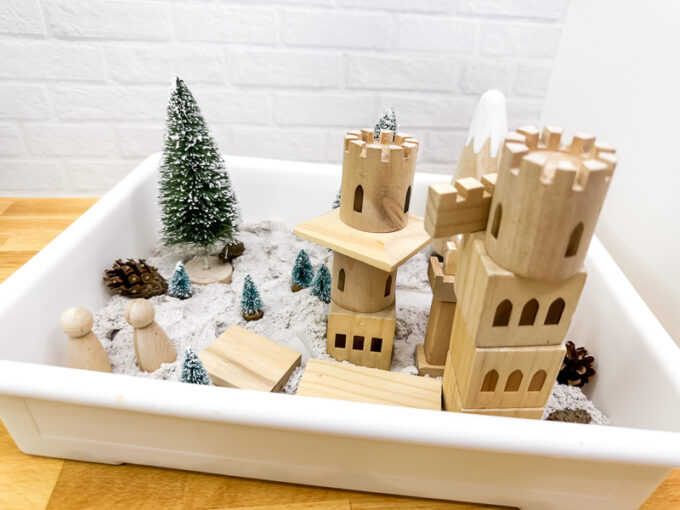
Letter Sounds Sensory Bin
Make an icy tower of foam letters, and related objects, and add to a bin with basters and squirt bottles. Kids can have fun practicing letter recognition, sounds, and fine motor skills while engaging in water sensory play.
Ocean Sensory Bin
Read more about this ocean sensory play idea and grab the free ocean animals coloring book!
Penguin Sensory Bin
Combine sensory play, books, a little math, and animal habitats all rolled into one for a fun activity for toddlers to preschoolers.
Pumpkin Sensory Bin
Grab a few simple supplies and turn a sensory bin into a pumpkin patch young kids will love exploring for fall.
Rainbow Rice Sensory Bin
Kids love to play with rice, and this colorful rainbow rice sensory bin is easy to put together yourself!
Space Theme Sensory Bin
Moon sand is another favorite filler to play with and make! We could also call this space sand as we added a fun space theme to our play.
Space Sensory Bin
Here is another easy idea for space theme sensory play! This sensory bin uses black aquarium rocks as the filler.
Tropical Summer Sensory Bin
Create a tropical summer sensory bin with play sand and summer theme play items.
Watermelon Rice Sensory Bin
Use our how to dye rice tutorial to make a batch of green and a double batch of red rice! Leave one batch of rice uncolored. Grab a packet of watermelon seeds and a small bowl! You can also add tongs and a small scoop. Super simple and fun. Enjoy a snack of watermelon too!
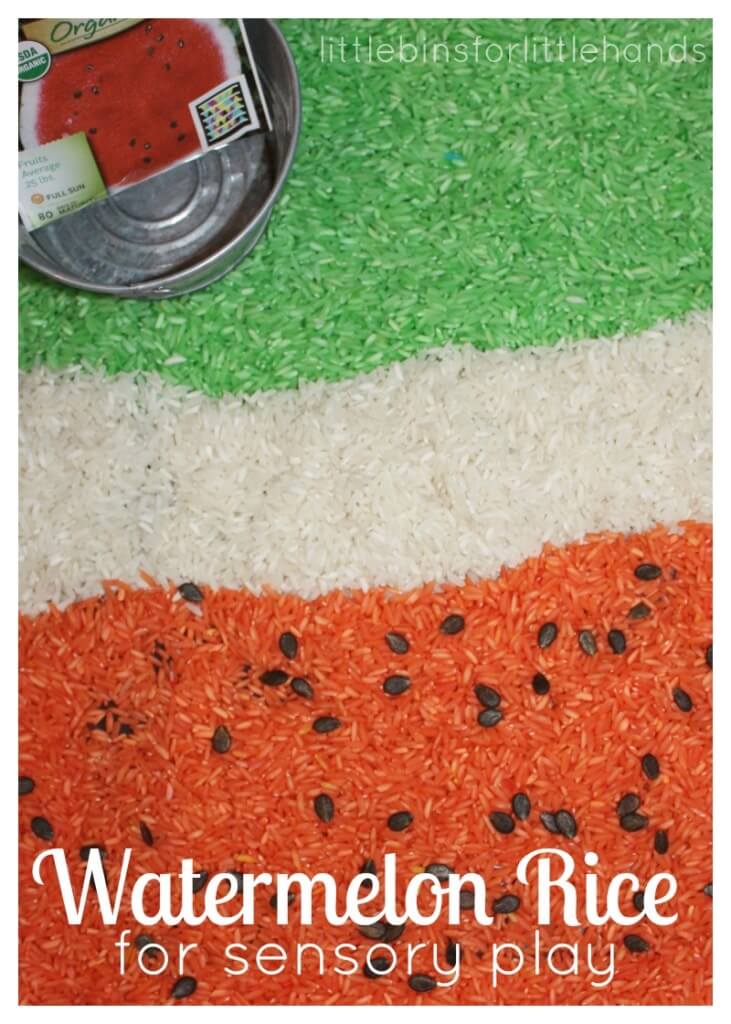
Weather Sensory Bin
Set up a colorful sensory bin with soft pom poms that represent the cloud, sun and rain. Check out the activity ideas too!
Farm Sensory Bin
Supplies Needed:
- A great book! We chose My Little People Farm.
- Sensory bin filler. We chose rice. See more non food filler ideas here.
- Items that fit with the book. Such as paper or plastic farm animals for a farm book.
- Add a bucket and scoop for simple sensory play.
Simple Sensory Bin Play Ideas
- Sing a song such as Old MacDonald and use the props too!
- Act out the story with the props.
- Count! We counted the farm animals.
- Sort the animals.
- Play hide and seek with the animals.
- Work on animal sounds.
- Feed the animals.
- Enjoy dumping and filling.
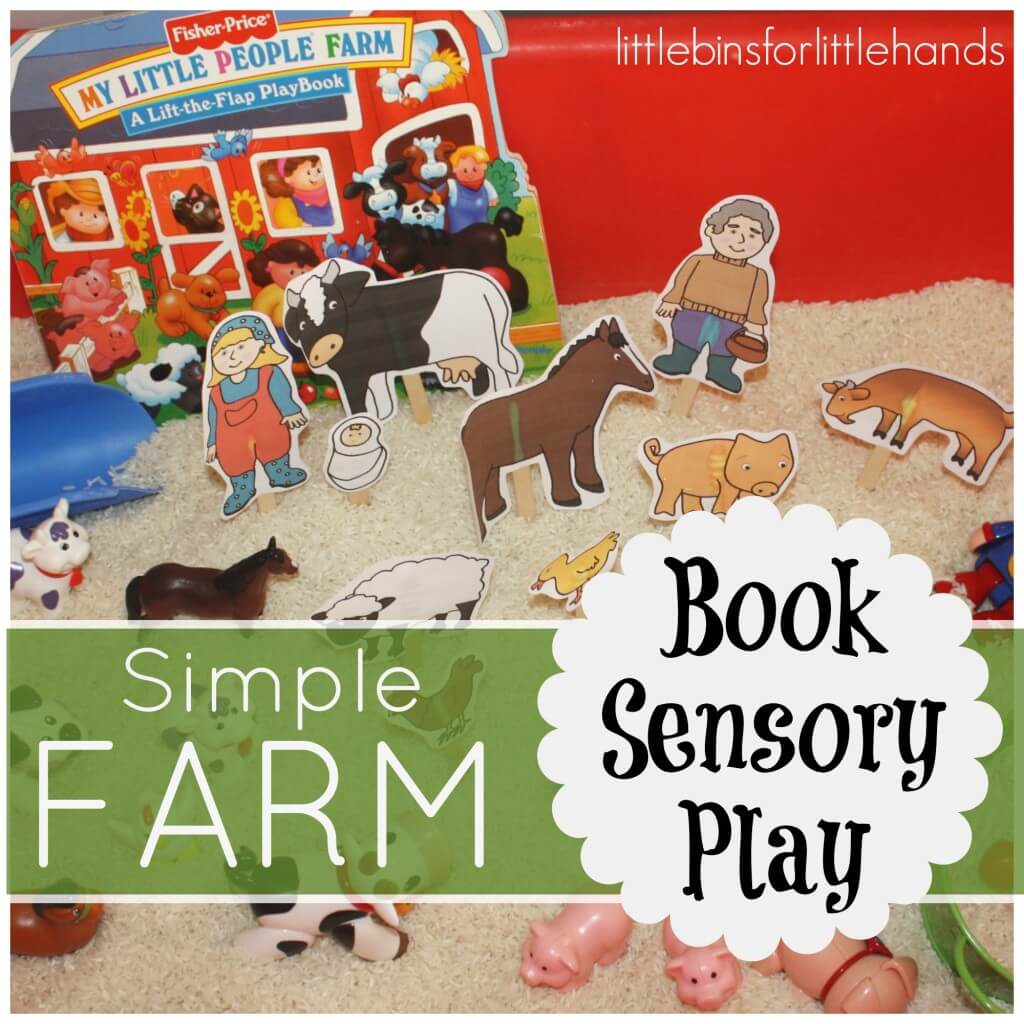
Water Sensory Bin Ideas
Sponges, colanders, strainers, food basters, and an aquarium net! All of these are fun items to add to a water sensory bin. Try some of these additions:
- Add a few plastic animals to wash and soap bubbles!
- Add plastic Easter eggs to a quick sensory bin.
- Make a letter wash with dollar store letter and number styrofoam puzzles.
- Add cotton balls to water and explore absorption!
Explore 12 easy to set up water sensory bin ideas here!
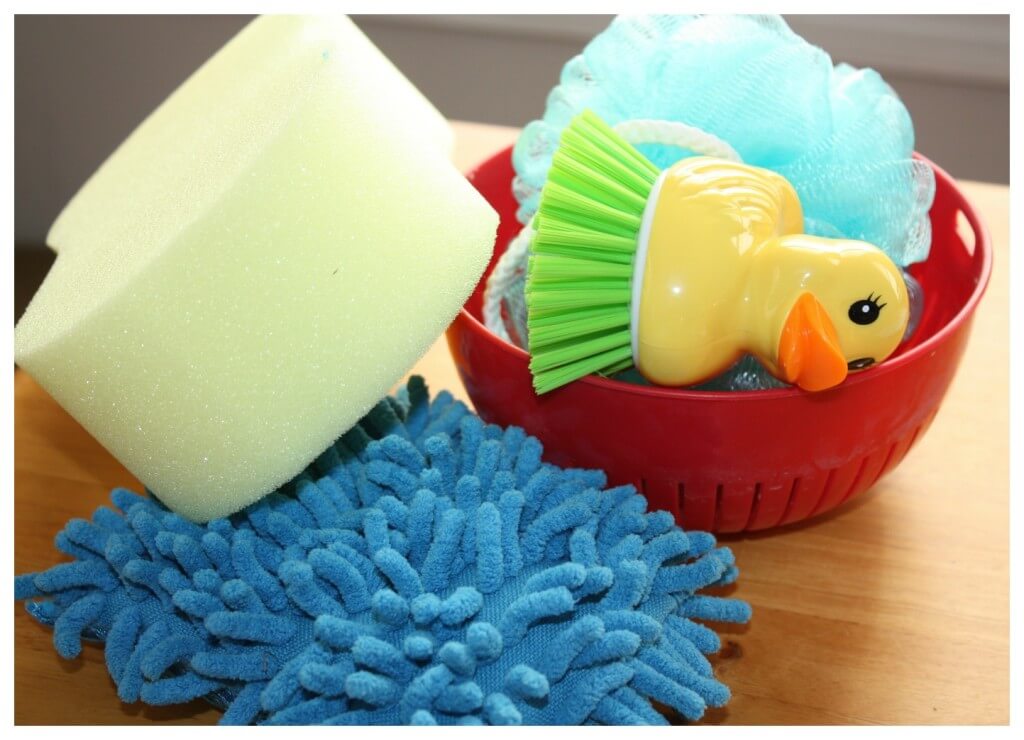
The Best Sensory Bin, Tub, or Sensory Table To Use
Please note I am sharing Amazon Affiliate links below. I may receive compensation through any purchases made.
What containers are best for sensory bins?
You want to start with the right sensory bin or tub when creating a sensory bin for kids of all ages. With the right size bin, kids will be at ease playing with the contents, and the mess can be kept to a minimum.
Is a sensory table a good choice?
A more expensive, heavy-duty sensory table, such as this one, allows one or more kids to stand and play comfortably. This was always my son’s favorite sensory bin, and it works just as well for home use as it does in the classroom. Roll it right outside!
If you need a sensory bin set on a table, make sure the sides are not too tall so kids do not feel like they are struggling to reach into it. Aim for a side height of around 3.25 inches. If you can place it on a child-size table, that makes it much better.
Under the bed storage bins also work well for this. Grab a plastic kitchen sink dish pan from the dollar store if you need a quick, cheap alternative!
Unless you have space restrictions, try to pick a size that gives your kids room to play around without continually knocking the contents out of the bin. These more compact sensory bins with lids are a good alternative.
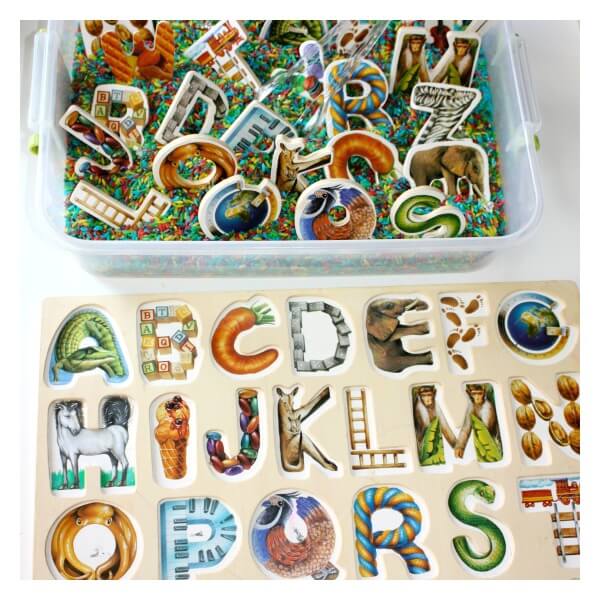
Sensory Bin Tips and Tricks
There is no wrong way to present a sensory bin! I usually put something together and leave it out for my son as an invitation to explore. Some kids may be especially curious and ready to explore, so stand back and enjoy watching! It’s ok to join the fun but don’t direct the play!
TIP: Due to various sensory needs, some kids may feel more comfortable standing to engage in the activity. Sitting on the floor or kneeling in front of a sensory bin may also be uncomfortable. My son’s sensory needs made standing the best choice for us.
A sensory bin is also a great opportunity for independent play. Some kids may be reluctant to start or don’t know how to start and need your help modeling play ideas. Dig in with them to show them how fun exploring can be. Scoop, dump, fill, and pour yourself!
Talk about what you are doing, seeing, and feeling. Ask them questions too! Play cooperatively or individually with your child. You know your child best!
TIP: It can be easy to feel like you should add more things to the sensory bin while your child is playing with it, but try to resist the urge! Too many items can be overwhelming, and you may end up disturbing your kiddo’s play flow if you interrupt them. Sit back and enjoy your coffee and watch them play!
Control the Mess!
Everyone asks about the mess! Toddlers especially can’t resist dumping things. We have had sensory bins in our house for so long that the mess is minimal. The younger the child, the more challenging it will be to teach the proper use of the sensory bin. But with time, patience, and consistency, it will happen.
TRICK: It’s important for the adult to model the appropriate use of sensory bins and to keep a close eye on young kids who may want to throw the filler and items. Keep a kid-size broom and dustpan handy to help them learn how to clean up spills.
I treat sensory bins as any other toy in the house. We don’t throw our toys; we respect them. We don’t scatter them around the house just because we feel like it; we use them and put them away. Of course, there are accidents! We still have them, and it’s OK!
We also have a small dustpan and broom handy, and it is great for fine motor work picking up loose beans or other fillers! If a child gets into the habit of throwing for fun, your sensory bin play will be less productive and more frustrating.
READ MORE: Easy Clean-Up Tips For Messy Play
Are Sensory Bins Worth It?
Yes, they are worth it. The more basic you keep the sensory bin, the better off you are. Remember, you create a tactile experience for your kids, not a Pinterest image. While we have fantastic pictures of sensory bins, they only stay that way for a minute!
Sensory bins are awesome hands-on tools for children to learn about their world and senses! Sensory play may calm a child, focus a child, and engage a child. Read about the many benefits below.
Here’s what children can learn from sensory bins:
- Practical Life Skills ~ Sensory bins let a child explore, discover and create play using practical life skills (dumping, filling, scooping) and learn valuable play skills.
- Play Skills {emotional development} ~ For both social play and independent play, sensory bins allow children to play cooperatively or side by side. My son has had many positive experiences with other children over a bin of rice!
- Language Development ~ Sensory bins increase language development by experiencing all there is to see and do with their hands, which leads to great conversations and opportunities to model language.
- Understanding 5 Senses ~ Many sensory play bins include a few senses! The five senses are touch, sight, sound, taste, and smell. Children can experience several at a time with a sensory bin. Imagine a bin of brightly colored rainbow rice: touch the loose grains against the skin, see the vivid colors as they mix together, and hear the sound of sprinkling over a plastic container or shaken in a plastic egg! Did you add a scent like vanilla or lavender? Please do not taste uncooked rice, but there are plenty of sensory play options that you use edible ingredients like our worms in magic mud!
Sensory Bin Ideas By Holiday & Season
Ok, time to put together a sensory bin. Check out this list of sensory bin ideas for the holidays or season.
- Valentine Sensory Bin
- Easter Sensory Bin
- LEGO Sensory Bin
- Spring Sensory Bin
- Spring Garden Sensory Bin
- Fall Sensory Bins
- Earl The Squirrel: Book and Bin
- Halloween Sensory Bin
- Halloween Sensory Ideas
- Christmas Sensory Bins
Printable Preschool Bundle Theme Pack
Get ready to explore this year with our growing Preschool STEM Bundle!
What’s Included:
There are 5 fun preschool themes to get you started. This is an ” I can explore” series!
Each unit contains approximately 15 activities, with instructions and templates as needed. Hands-on activities are provided to keep it fun and exciting. This includes sensory bins, experiments, games, and more! Easy supplies keep it low cost and book suggestions add the learning time.


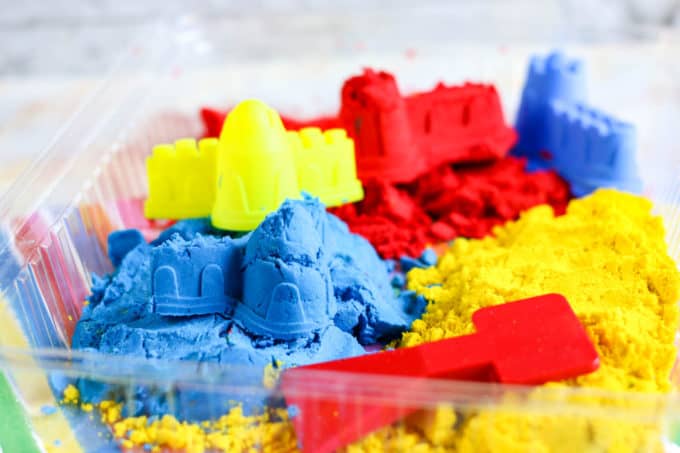
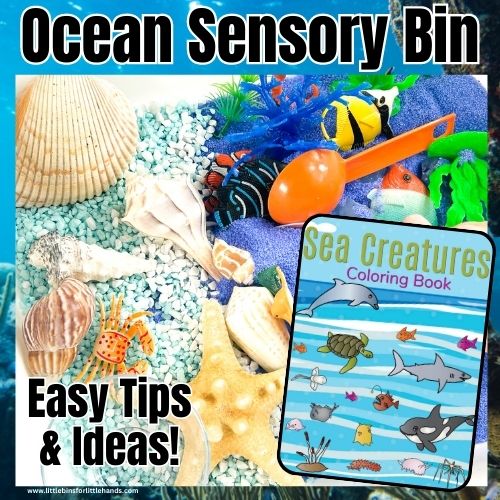
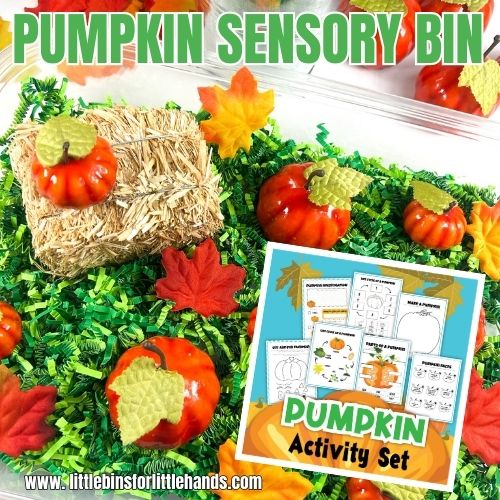

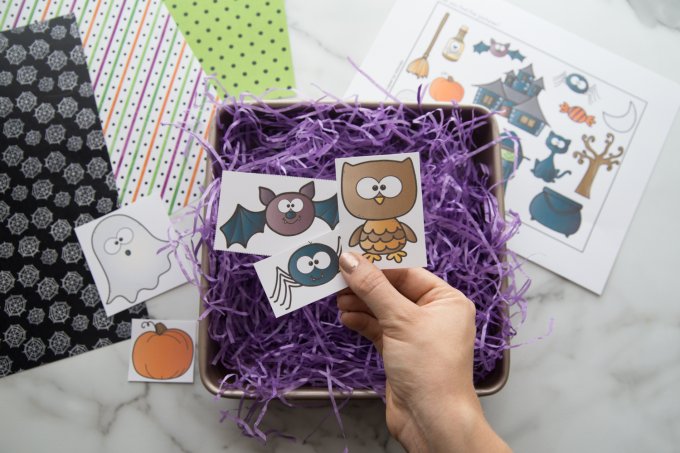
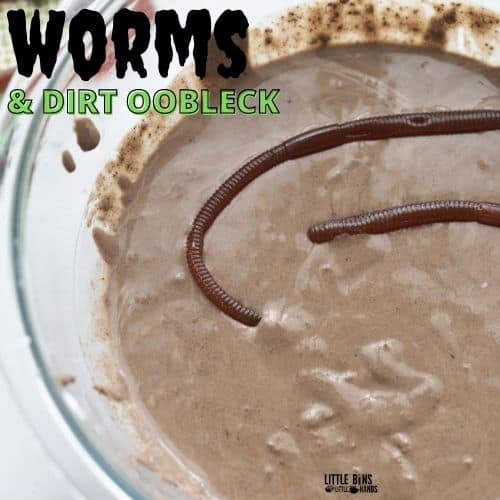
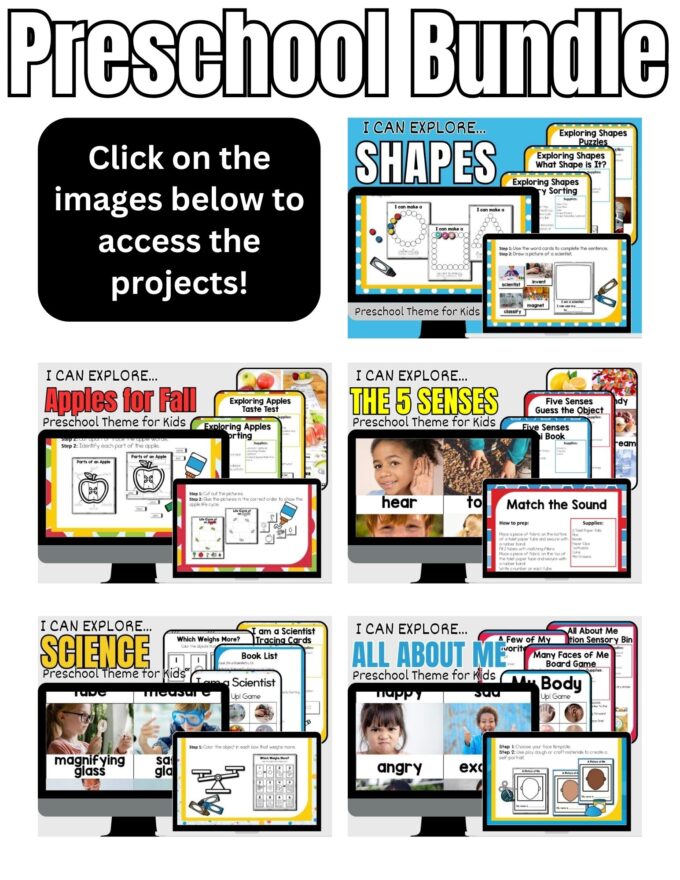






Great post! My boys just love sensory bins. My girls don’t care for them due to tactile sensitivities. Still, as often as I can, I try to put one together for everyone.
Love sensory play here! The kids like to get involved in creating them now if they see me making one up! And pouring things from container to container never gets old! (Even the kindergartner has fun!)
Pinning to my sensory board!
What a great resource, especially for those new to putting these together. I also love all your links to some of your favorite bins.
Found your site through Pinterest. My son loves his rice play, and for whatever reason I have never even thought of trying different textures or themes. This opens up a whole new world of possibilities for my preschooler. 🙂 Thanks for sharing!
I have a tip to share, too. For smaller children who may have trouble controlling the urge for bigger motions, you can place a fitted sheet on the floor and use gallon jugs filled with water in the corners to create a large, enclosed work surface with sort walls. We use a twin sized sheet in our kitchen for our little guy’s work space, but even a crib sheet would create a nice work area that helps contain the mess. We also have always given him two bins instead of one, because we found he likes to constantly transfer the rice from one bin to the other.
Here are a few more good examples of themed sensory bins http://funprojectsforyourkids.blogspot.com/
May I just say sensory bins can be used for kids but the y are also used for mentally ill people so please don’t say it’s just for young children 🙂